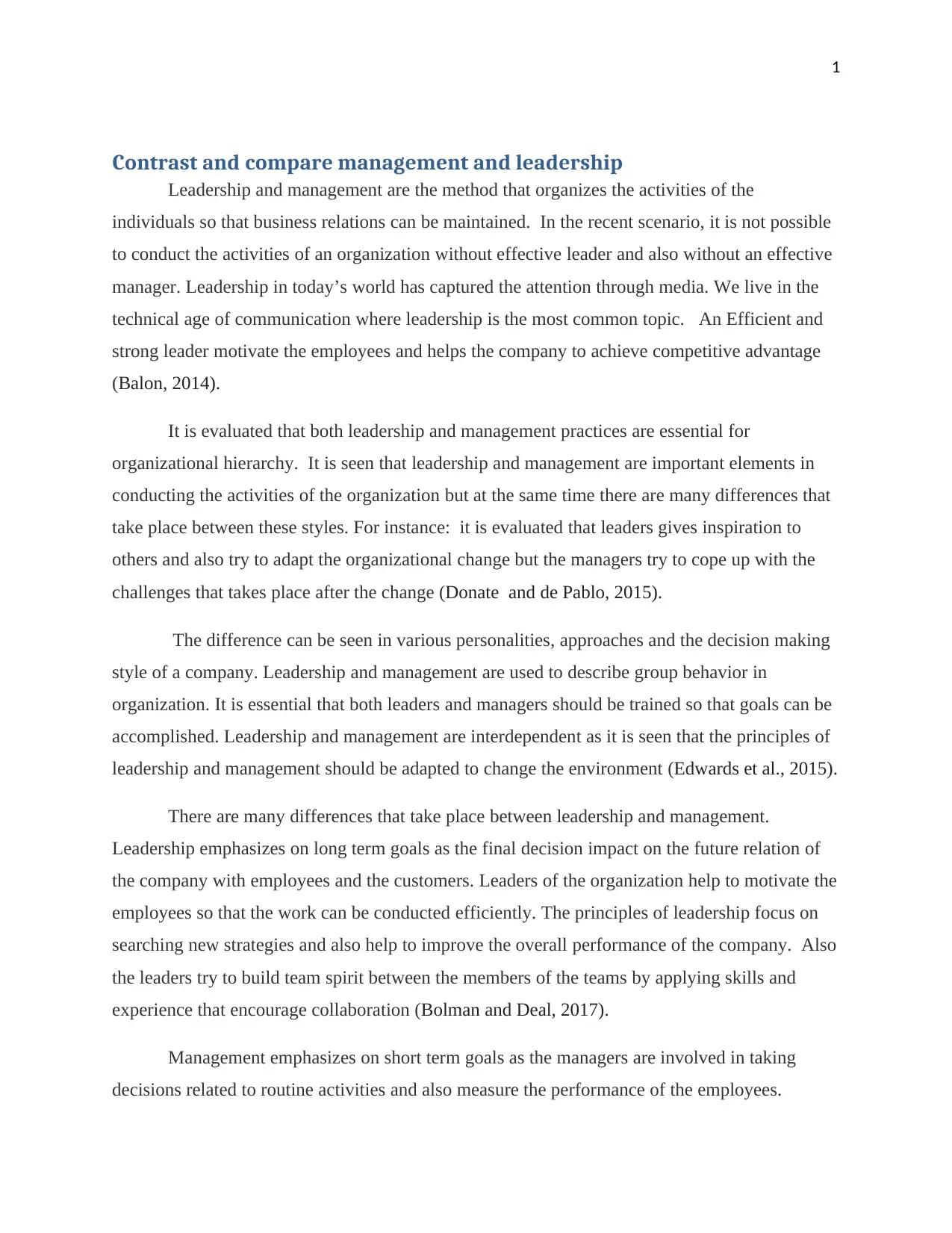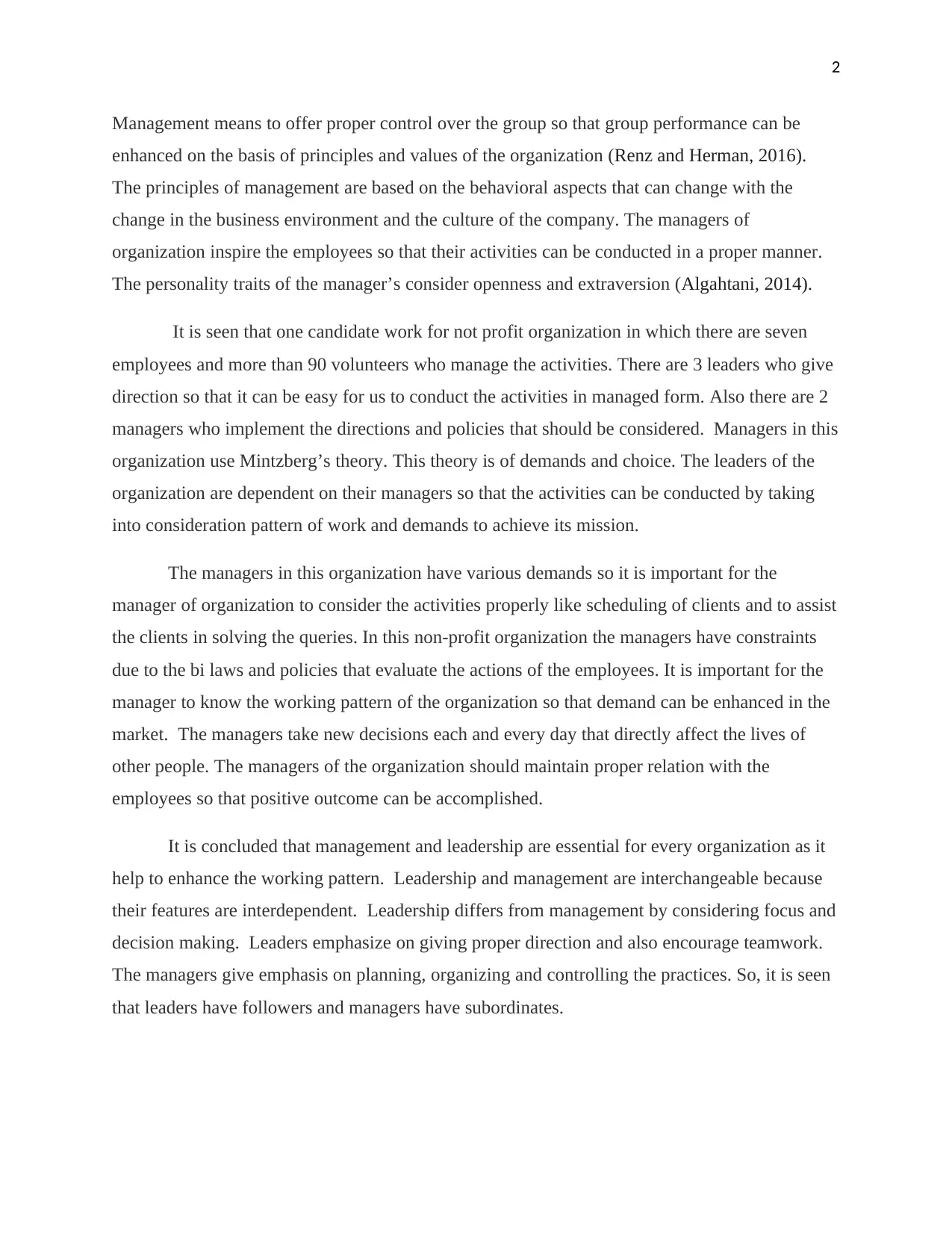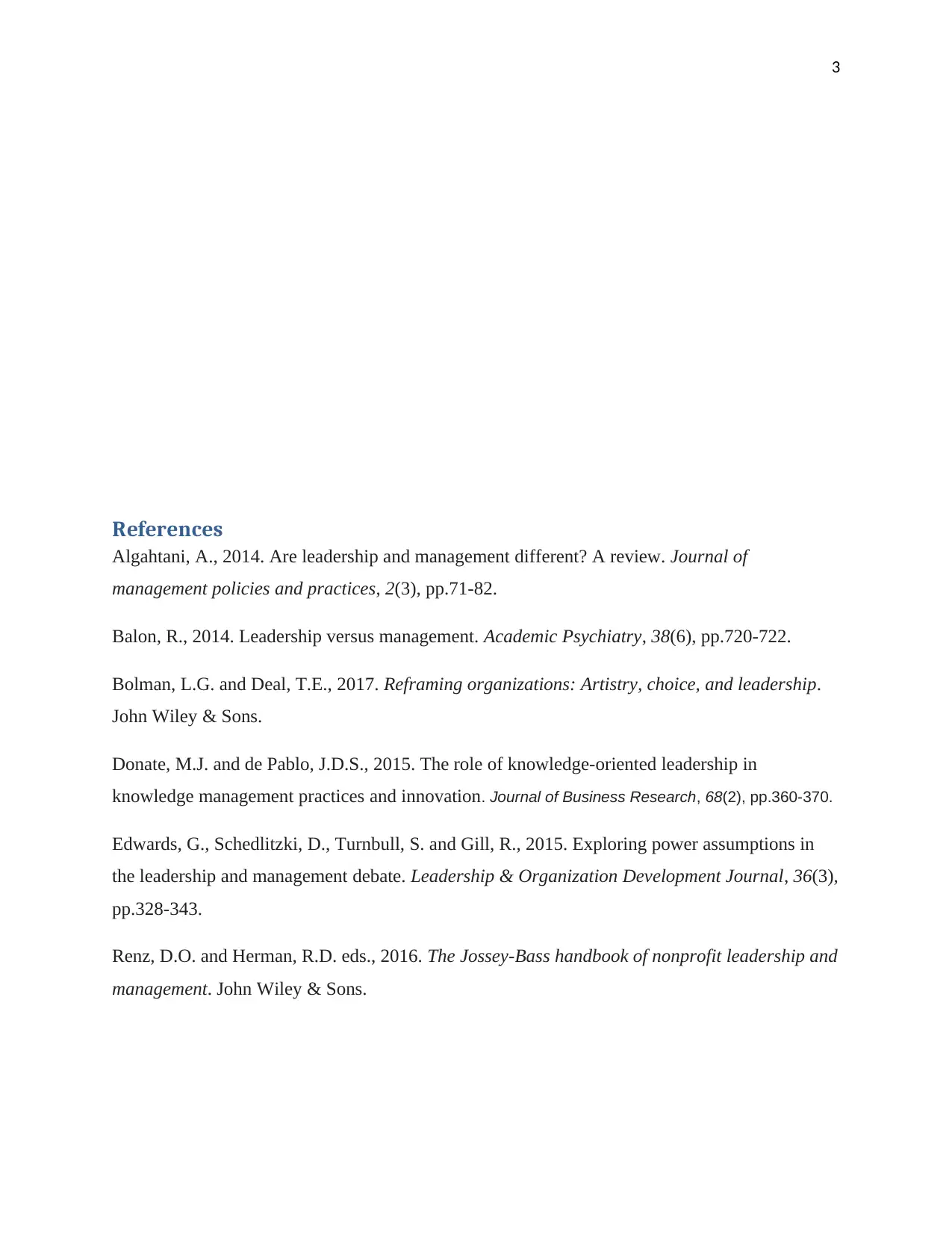Reflective Essay: Contrasting and Comparing Management and Leadership
VerifiedAdded on 2021/04/24
|4
|1011
|177
Essay
AI Summary
This essay provides a reflective comparison and contrast of leadership and management practices within organizations. It highlights the differences in their approaches, goals, and impact on employees and organizational outcomes. The essay discusses how leaders inspire and adapt to change, while managers focus on coping with challenges and achieving short-term goals through effective planning and control. It emphasizes the importance of both leadership and management for organizational success, with leaders focusing on long-term strategies and team building, and managers focusing on day-to-day operations and performance measurement. The essay also considers how these principles are applied in a non-profit organization, illustrating the practical application of leadership and management theories. It concludes that while distinct, leadership and management are interdependent and crucial for enhancing organizational effectiveness.

Running head: Reflective Essay
Reflective Essay
Reflective Essay
Paraphrase This Document
Need a fresh take? Get an instant paraphrase of this document with our AI Paraphraser

1
Contrast and compare management and leadership
Leadership and management are the method that organizes the activities of the
individuals so that business relations can be maintained. In the recent scenario, it is not possible
to conduct the activities of an organization without effective leader and also without an effective
manager. Leadership in today’s world has captured the attention through media. We live in the
technical age of communication where leadership is the most common topic. An Efficient and
strong leader motivate the employees and helps the company to achieve competitive advantage
(Balon, 2014).
It is evaluated that both leadership and management practices are essential for
organizational hierarchy. It is seen that leadership and management are important elements in
conducting the activities of the organization but at the same time there are many differences that
take place between these styles. For instance: it is evaluated that leaders gives inspiration to
others and also try to adapt the organizational change but the managers try to cope up with the
challenges that takes place after the change (Donate and de Pablo, 2015).
The difference can be seen in various personalities, approaches and the decision making
style of a company. Leadership and management are used to describe group behavior in
organization. It is essential that both leaders and managers should be trained so that goals can be
accomplished. Leadership and management are interdependent as it is seen that the principles of
leadership and management should be adapted to change the environment (Edwards et al., 2015).
There are many differences that take place between leadership and management.
Leadership emphasizes on long term goals as the final decision impact on the future relation of
the company with employees and the customers. Leaders of the organization help to motivate the
employees so that the work can be conducted efficiently. The principles of leadership focus on
searching new strategies and also help to improve the overall performance of the company. Also
the leaders try to build team spirit between the members of the teams by applying skills and
experience that encourage collaboration (Bolman and Deal, 2017).
Management emphasizes on short term goals as the managers are involved in taking
decisions related to routine activities and also measure the performance of the employees.
Contrast and compare management and leadership
Leadership and management are the method that organizes the activities of the
individuals so that business relations can be maintained. In the recent scenario, it is not possible
to conduct the activities of an organization without effective leader and also without an effective
manager. Leadership in today’s world has captured the attention through media. We live in the
technical age of communication where leadership is the most common topic. An Efficient and
strong leader motivate the employees and helps the company to achieve competitive advantage
(Balon, 2014).
It is evaluated that both leadership and management practices are essential for
organizational hierarchy. It is seen that leadership and management are important elements in
conducting the activities of the organization but at the same time there are many differences that
take place between these styles. For instance: it is evaluated that leaders gives inspiration to
others and also try to adapt the organizational change but the managers try to cope up with the
challenges that takes place after the change (Donate and de Pablo, 2015).
The difference can be seen in various personalities, approaches and the decision making
style of a company. Leadership and management are used to describe group behavior in
organization. It is essential that both leaders and managers should be trained so that goals can be
accomplished. Leadership and management are interdependent as it is seen that the principles of
leadership and management should be adapted to change the environment (Edwards et al., 2015).
There are many differences that take place between leadership and management.
Leadership emphasizes on long term goals as the final decision impact on the future relation of
the company with employees and the customers. Leaders of the organization help to motivate the
employees so that the work can be conducted efficiently. The principles of leadership focus on
searching new strategies and also help to improve the overall performance of the company. Also
the leaders try to build team spirit between the members of the teams by applying skills and
experience that encourage collaboration (Bolman and Deal, 2017).
Management emphasizes on short term goals as the managers are involved in taking
decisions related to routine activities and also measure the performance of the employees.

2
Management means to offer proper control over the group so that group performance can be
enhanced on the basis of principles and values of the organization (Renz and Herman, 2016).
The principles of management are based on the behavioral aspects that can change with the
change in the business environment and the culture of the company. The managers of
organization inspire the employees so that their activities can be conducted in a proper manner.
The personality traits of the manager’s consider openness and extraversion (Algahtani, 2014).
It is seen that one candidate work for not profit organization in which there are seven
employees and more than 90 volunteers who manage the activities. There are 3 leaders who give
direction so that it can be easy for us to conduct the activities in managed form. Also there are 2
managers who implement the directions and policies that should be considered. Managers in this
organization use Mintzberg’s theory. This theory is of demands and choice. The leaders of the
organization are dependent on their managers so that the activities can be conducted by taking
into consideration pattern of work and demands to achieve its mission.
The managers in this organization have various demands so it is important for the
manager of organization to consider the activities properly like scheduling of clients and to assist
the clients in solving the queries. In this non-profit organization the managers have constraints
due to the bi laws and policies that evaluate the actions of the employees. It is important for the
manager to know the working pattern of the organization so that demand can be enhanced in the
market. The managers take new decisions each and every day that directly affect the lives of
other people. The managers of the organization should maintain proper relation with the
employees so that positive outcome can be accomplished.
It is concluded that management and leadership are essential for every organization as it
help to enhance the working pattern. Leadership and management are interchangeable because
their features are interdependent. Leadership differs from management by considering focus and
decision making. Leaders emphasize on giving proper direction and also encourage teamwork.
The managers give emphasis on planning, organizing and controlling the practices. So, it is seen
that leaders have followers and managers have subordinates.
Management means to offer proper control over the group so that group performance can be
enhanced on the basis of principles and values of the organization (Renz and Herman, 2016).
The principles of management are based on the behavioral aspects that can change with the
change in the business environment and the culture of the company. The managers of
organization inspire the employees so that their activities can be conducted in a proper manner.
The personality traits of the manager’s consider openness and extraversion (Algahtani, 2014).
It is seen that one candidate work for not profit organization in which there are seven
employees and more than 90 volunteers who manage the activities. There are 3 leaders who give
direction so that it can be easy for us to conduct the activities in managed form. Also there are 2
managers who implement the directions and policies that should be considered. Managers in this
organization use Mintzberg’s theory. This theory is of demands and choice. The leaders of the
organization are dependent on their managers so that the activities can be conducted by taking
into consideration pattern of work and demands to achieve its mission.
The managers in this organization have various demands so it is important for the
manager of organization to consider the activities properly like scheduling of clients and to assist
the clients in solving the queries. In this non-profit organization the managers have constraints
due to the bi laws and policies that evaluate the actions of the employees. It is important for the
manager to know the working pattern of the organization so that demand can be enhanced in the
market. The managers take new decisions each and every day that directly affect the lives of
other people. The managers of the organization should maintain proper relation with the
employees so that positive outcome can be accomplished.
It is concluded that management and leadership are essential for every organization as it
help to enhance the working pattern. Leadership and management are interchangeable because
their features are interdependent. Leadership differs from management by considering focus and
decision making. Leaders emphasize on giving proper direction and also encourage teamwork.
The managers give emphasis on planning, organizing and controlling the practices. So, it is seen
that leaders have followers and managers have subordinates.
⊘ This is a preview!⊘
Do you want full access?
Subscribe today to unlock all pages.

Trusted by 1+ million students worldwide

3
References
Algahtani, A., 2014. Are leadership and management different? A review. Journal of
management policies and practices, 2(3), pp.71-82.
Balon, R., 2014. Leadership versus management. Academic Psychiatry, 38(6), pp.720-722.
Bolman, L.G. and Deal, T.E., 2017. Reframing organizations: Artistry, choice, and leadership.
John Wiley & Sons.
Donate, M.J. and de Pablo, J.D.S., 2015. The role of knowledge-oriented leadership in
knowledge management practices and innovation. Journal of Business Research, 68(2), pp.360-370.
Edwards, G., Schedlitzki, D., Turnbull, S. and Gill, R., 2015. Exploring power assumptions in
the leadership and management debate. Leadership & Organization Development Journal, 36(3),
pp.328-343.
Renz, D.O. and Herman, R.D. eds., 2016. The Jossey-Bass handbook of nonprofit leadership and
management. John Wiley & Sons.
References
Algahtani, A., 2014. Are leadership and management different? A review. Journal of
management policies and practices, 2(3), pp.71-82.
Balon, R., 2014. Leadership versus management. Academic Psychiatry, 38(6), pp.720-722.
Bolman, L.G. and Deal, T.E., 2017. Reframing organizations: Artistry, choice, and leadership.
John Wiley & Sons.
Donate, M.J. and de Pablo, J.D.S., 2015. The role of knowledge-oriented leadership in
knowledge management practices and innovation. Journal of Business Research, 68(2), pp.360-370.
Edwards, G., Schedlitzki, D., Turnbull, S. and Gill, R., 2015. Exploring power assumptions in
the leadership and management debate. Leadership & Organization Development Journal, 36(3),
pp.328-343.
Renz, D.O. and Herman, R.D. eds., 2016. The Jossey-Bass handbook of nonprofit leadership and
management. John Wiley & Sons.
1 out of 4
Related Documents
Your All-in-One AI-Powered Toolkit for Academic Success.
+13062052269
info@desklib.com
Available 24*7 on WhatsApp / Email
![[object Object]](/_next/static/media/star-bottom.7253800d.svg)
Unlock your academic potential
Copyright © 2020–2025 A2Z Services. All Rights Reserved. Developed and managed by ZUCOL.





